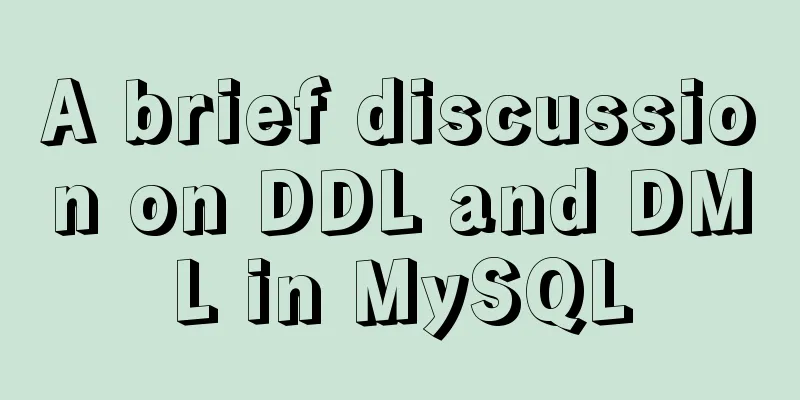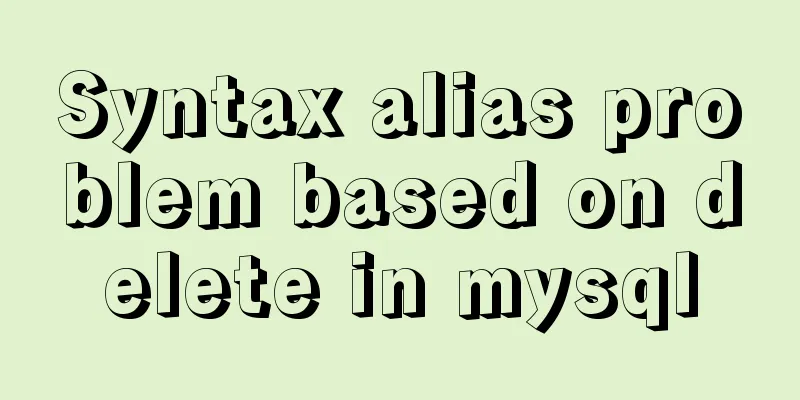A brief discussion on DDL and DML in MySQL

PrefaceIn the previous article, we learned about MySQL and became familiar with how to use MySQL query statements. We have already introduced the query in the data operation of adding, deleting, querying and modifying. This article will introduce the remaining additions, deletions, modifications and common operations of databases and tables, such as creation, deletion and modification. 1. DDLSome readers may ask, what is DDL? Here the blogger briefly introduces that the full name of DDL is Data Define Languge. From English, we can easily translate it into data definition language , which is used to create, modify and delete libraries and tables. 1.1 Database Operations1.1.1 Creating and using a database #Create a database CREATE DATABASE database name; #Create a database. First determine whether the database exists, then create it. CREATE DATABASE IF NOT EXISTS database name; #Create a database and specify the character set CREATE DATABASE database name CHARACTER SET character set; #Use database USE database name; 1.1.2 Querying the Database #Query the names of all databases SHOW DATABASES; #Query the character set of a database: query the creation statement of a database SHOW CREATE DATABASE database name; #Query the name of the database being used SELECT DATABASE(); 1.1.3 Modify the character set of the database #Modify the character set of the database ALTER DATABASE database library name CHARACTER SET character set name; 1.1.4 Deleting a database #Delete the database DROP DATABASE database name; #Judge whether the database exists, and then delete it DROP DATABASE IF EXISTS database name; 1.2 Data Table Operation1.2.1 Create a data table #Create a data table CREATE TABLE table name ( Column 1 Data Type [Constraint], Column 2 Data Type [Constraint], ... Column n Data type [constraint] ); Note : No commas are needed in the last sentence. 1.2.2 Query Data Table #Query all tables in the current database SHOW TABLES; #Query all tables in a database SHOW TABLES FROM database name; #Query table structure DESC table name; 1.2.3 Modify the data table #Change the table name ALTER TABLE table name RENAME TO new table name; #Modify the character set of the table ALTER TABLE table name CHARACTER SET character set; #Add a column ALTER TABLE table name ADD column name data type; #Modify column name and data type ALTER TABLE table name CHANGE column name new column type new data type; ALTER TABLE table name MODIFY column name new data type; #Delete columns ALTER TABLE table name DROP column name; 1.2.4 Deleting a Data Table #Delete the data table DROP TABLE data table; #First determine whether the data table exists, then delete the DROP TABLE IF EXISTS data table; In fact, the keywords for operating on databases and data tables are the same, except that it is indicated afterwards whether the operation is on a database or a data table. If you are operating on a database , add database ; if you are operating on a data table , add table. 1.3 Common Data Types
1.4 ConstraintsConcept: Limit the data in the table to ensure the correctness, validity and completeness of the data. 1.5 Identity ColumnAuto-increment Add auto_increment after the field 2. DMLAfter introducing DDL, let's take a look at DML. The full name of DML is Data Manipulate Language, which is also literally translated as data processing language . DML is used to add, delete, modify database records, and check data integrity. 2.1 Add data#Add data INSERT INTO table name (column name 1,...) VALUES (value 1,...); INSERT INTO table name SET column name 1 = value 1,..., column name n = value n; When adding data, please note : 1. Column names and values need to correspond one to one. 2. The number of columns and values must be consistent. 3. If the column name is omitted, values are added to all columns by default. 2.2 Modify data#Modify single table data UPDATE table name SET column name 1 = value 1,..., column name n = value n [WHERE filter condition]; #Modify multi-table data UPDATE table 1 alias, table 2 alias SET field = new value,..., WHERE connection condition AND filter condition; Note : If no condition is added, all data in the table will be modified. 2.3 Deleting Data#Delete data DELETE FROM table name [WHERE condition]; #If no condition is added, all records in the table will be deleted. #Delete all records in the table DELETE FROM table name; ----Not recommended. TRUNCATE TABLE table name; -----Recommended, highly efficient. Comparison between delete and truncate :
This is the end of this article about DDL and DML in MySQL. For more information about DDL and DML in MySQL, please search for previous articles on 123WORDPRESS.COM or continue to browse the following related articles. I hope you will support 123WORDPRESS.COM in the future! You may also be interested in:
|
<<: Detailed explanation of CSS elastic box flex-grow, flex-shrink, flex-basis
>>: How to convert a string into a number in JavaScript
Recommend
CentOS 6 uses Docker to deploy redis master-slave database operation example
This article describes how to use docker to deplo...
A brief discussion on the execution details of Mysql multi-table join query
First, build the case demonstration table for thi...
TortoiseSvn Little Turtle Installation Latest Detailed Graphics Tutorial
There were always problems when installing tortoi...
Some findings and thoughts about iframe
This story starts with an unexpected discovery tod...
Analysis of MySQL duplicate index and redundant index examples
This article uses examples to describe MySQL dupl...
Detailed explanation of JavaScript data types
Table of contents 1. Literals 1.1 Numeric literal...
Detailed graphic tutorial on how to install the unzipped version of MySQL under Windows 10
MySQL installation is divided into installation v...
How to run sudo command without entering password in Linux
The sudo command allows a trusted user to run a p...
The content of the commonly used input text box is automatically vertically centered and the default prompt text is empty when clicked
Three functions: 1. Automatic vertical centering o...
Detailed explanation of the complete usage example of developing hyperf under Docker
Hyperf official website Hyperf official documenta...
JavaScript to achieve full or reverse selection effect in form
This article shares the specific code of JavaScri...
Specific use of the autoindex module in the Nginx Http module series
The main function of the brower module is to dete...
Summary of some reasons why crontab scheduled tasks are not executed
Preface I recently encountered some problems at w...
Vue project @change multiple parameters to pass multiple events
First, there is only one change event. changeleve...
Jenkins packaging microservices to build Docker images and run them
Table of contents Environment Preparation start 1...












